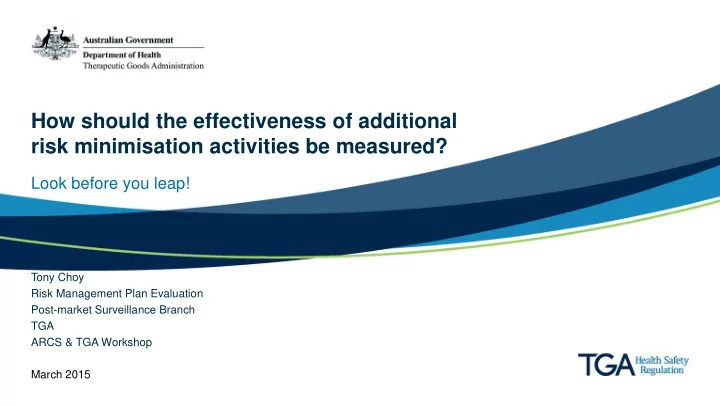

How should the effectiveness of additional risk minimisation activities be measured? Look before you leap! Tony Choy Risk Management Plan Evaluation Post-market Surveillance Branch TGA ARCS & TGA Workshop March 2015
RMP Questions & Answers (Version 2.0, March 2015) • The sponsor is responsible for monitoring and evaluating the effectiveness of additional risk minimisation activities. • The proposed risk minimisation activities should be dependent on an assessment of the risk, the population, and how the risk changes during the course of the post-market period. • Guidance on the measurement of additional risk minimisation activities can be found in the EU Guideline on good pharmacovigilance practices (GVP) Module XVI– Risk minimisation measures: selection of tools and effectiveness indicators. How should the effectiveness of additional 1 risk minimisation activities be measured?
EU Guideline on GVP: Module V – Risk management systems (Rev 1) April 2014 • Risk minimisation measures are public health interventions intended to prevent or reduce the probability of the occurrence of adverse reactions associated with exposure to a medicinal product, or to reduce their severity/impact on the patient should the adverse reactions occur. • The success of risk minimisation activities in delivering these objectives needs to be evaluated throughout the lifecycle of a product to ensure that the burden of adverse reactions is minimised and hence the overall risk- benefit balance is optimised. • All risk minimisation measures should be reviewed at regular intervals and their effectiveness assessed. More extensive guidance on monitoring the effectiveness of risk minimisation activities is included in Module XVI. • Any educational material should be non-promotional. How should the effectiveness of additional 2 risk minimisation activities be measured?
Module XVI – Risk minimisation measures: selection of tools and effectiveness indicators Module XVI.B.1. General principles • The risk minimisation plan, an integral part of the RMP (see Module V), should give appropriate consideration to the following points: – Rationale for additional risk minimisation measure (linked to specific safety concerns) – Description of additional risk minimisation measure(s) – Implementation plan – Evaluation plan How should the effectiveness of additional 3 risk minimisation activities be measured?
Module XVI.B.4. Effectiveness of risk minimisation measures • Evaluating the effectiveness of risk minimisation measures is necessary to establish whether an intervention has been effective or not, and if not then why the intervention was not successful and whether corrective actions are necessary. • To evaluate the effectiveness of risk minimisation measures two indicators should be considered: – process indicators – outcome indicators • The conclusion of the evaluation • Has the risk minimisation intervention had unintended (negative) consequences? How should the effectiveness of additional 4 risk minimisation activities be measured?
Module XVI.B.4.1. Process indicators • Process indicators should complement but not replace outcome indicators. • Reaching the target population • Assessing clinical knowledge • Assessing clinical actions How should the effectiveness of additional 5 risk minimisation activities be measured?
Module XVI.B.4.2. Outcome indicators • The ultimate measures of success of a risk minimisation program are the safety outcomes, i.e. the frequency and/or severity of adverse reactions in relation to patients’ exposure to the medicine outside of an interventional study setting (i.e. non-interventional setting). • Such an evaluation should involve the comparison of epidemiologic measures of outcome frequency such as incidence rate or cumulative incidence of an adverse reaction, obtained in the context of post-authorisation safety studies. • As a general rule, spontaneous reporting rates (i.e. number of suspected adverse reaction reports over a fixed time period) should not be considered as an acceptable estimate of the frequency of adverse events in the treated population, as the well known biases that affects reporting of suspected adverse reaction may provide misleading results. How should the effectiveness of additional 6 risk minimisation activities be measured?
Consolidated ASA Template • Section 3.3 - How risk minimisation activities will be evaluated in Australia: – Provide detail about how and when evaluation of additional risk minimisation activities, including educational activities, will be undertaken and reported to the TGA. – Sponsors must demonstrate that the measures they are using to mitigate risk are working and if not what actions they will take to ensure effectiveness. How should the effectiveness of additional 7 risk minimisation activities be measured?
Pre-submitted Questions • If the EMA has not requested additional risk minimisation activities for specific safety concerns, how is it that the TGA considers this necessary in a local market, if the demographics of the patient population are considered to be similar? • How do we report on effectiveness of risk minimization activities? i.e. do we update the ASA and submit to TGA without an application (i.e. no Cat 1) – what is the evaluation process/application type? How long? Should we expect questions? • How do we remove risk minimization activities? What is the process/application type? i.e. do we update the ASA and submit to TGA without an application (i.e. no Cat 1) – what is the evaluation process? How long? Should we expect questions? How should the effectiveness of additional 9 risk minimisation activities be measured?
Pre-submitted Questions • Do changes to additional RMinA require pre-approval from TGA e.g. if text changes are made to an educational material? • What is your definition of an 'effectiveness measure' and in what circumstances would it be reasonable not to implement effectiveness measures? • Effectiveness measures often involve questionnaires sent out to HCPs. For many bio-similar products, the same effectiveness measures are expected which means the same HCPs can be receiving multiple questionnaires for a number of products, meaning response rate and feeling towards the industry is being damaged. How do you propose addressing this problem? How should the effectiveness of additional 10 risk minimisation activities be measured?
Recommend
More recommend